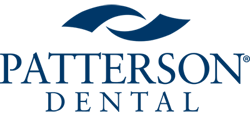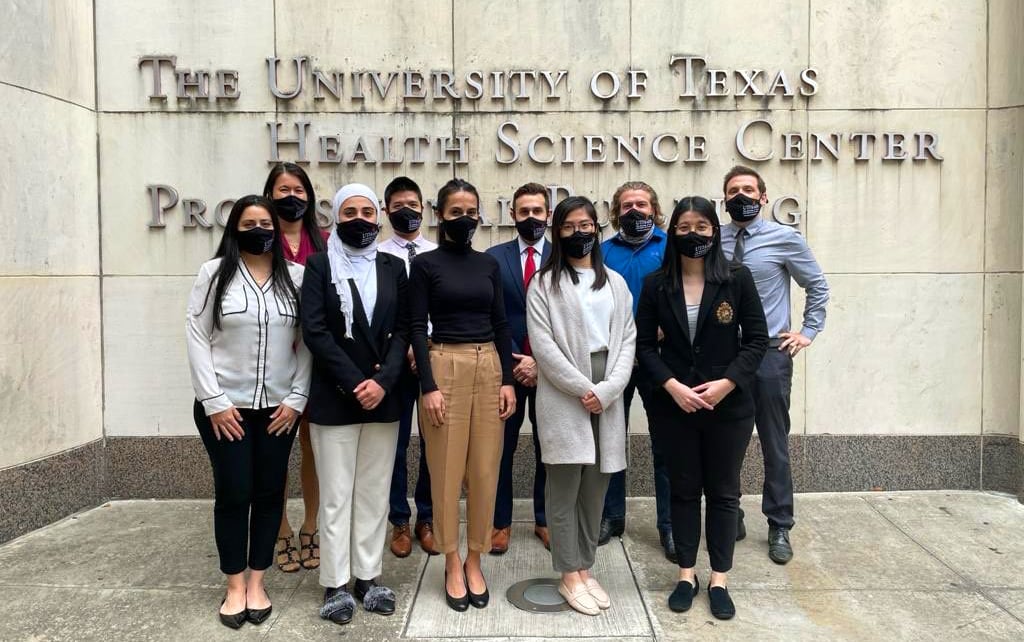
Introduction
On December 31, 2019, Chinese authorities reported an outbreak caused by a novel coronavirus, SARS-CoV-2.1 The virus causes mild to severe respiratory illness, known as Coronavirus Disease 2019 (COVID-19). The outbreak was first identified in Wuhan, Hubei Province, China. There is evidence that the virus was already circulating in other countries, such as northern Italy, since December 2019.2 On March 11, 2020, the World Health Organization declared COVID-19 a pandemic, which forced all professions throughout the world to adapt to the way they interact with their clients.1 COVID-19 has promoted more virtual interactions between businesses to help prevent further transmission of the virus. Most of the dental procedures cannot be provided virtually; adaptations in private practice, dental schools, and residency programs have been considerable. Beginning on March 16, 2020, the American Dental Association (ADA) called on dentists nationwide to postpone urgent dental procedures through April 30, 2020. This restructured how dentistry was performed for decades to help slow down the spread of COVID-19.3 Along with the phases of reopening, new restrictions and guidelines were recommended by the Centers for Disease Control and Prevention (CDC), including infection prevention and control (IPC) practices for routine dental care delivery and protocols for providing dental care to patients with suspected or confirmed SARS-CoV-2 infection.4 The ADA Health Policy Institute has reported poll data on the reopening of the US dental practices including its economic impact. Individually, states have adopted their own rules and phases of reopening depending on the number of local COVID-19 cases.5
As of early 2021, Texas remains one of the major epicenters of the pandemic with over 2 million cumulative cases. Harris County, where the University of Texas Health Science Center at Houston (UTHealth), School of Dentistry (UTSD), and the Advanced Education in General Dentistry (AEGD) program are located, has accumulated over three-hundred-thousand cases.6 The American Dental Education Association has reported how dental organizations are adjusting and adapting to the pandemic; however, students'/residents' opinions have not been expressed.7 The objective of this report is to document and understand the perspective of the AEGD class of 2021 during the new dental era since the COVID-19 pandemic.
Effects for Graduating Dental Students and Incoming Residents and their Mental Health during the COVID-19 Pandemic
Many dental schools in the United States (US) moved classes online and closed clinics indefinitely in response to CDC advisory and local government regulations in spring/summer 2020. Incoming residents reported losing two to three months of pre-doctoral clinical experiences. Many dental schools adjusted graduation requirements; students’ clinical competency was assessed on a case-by-case basis to determine if the student required more clinical experience before graduating. Many licensing clinical exams were postponed or canceled due to the closure of dental school clinics. The pandemic forced licensing organizations to administrate mannequin-based restorative exams instead of live-patient exams. Fourth-year dental students from across the nation organized via social media to appeal to the dental boards of different states to approve mannequin-based restorative licensing exams. As of today, most of the states have accepted the mannequin exam for the year 2020 and beyond.
The pandemic introduced widespread unpredictability and anxiety. Some graduating dental students returned home while others remained in their apartment or dorm. International students faced pressure to return home, and some were instructed by their government to evacuate the US. Students and residents were anxious and conflicted regarding whether they should go home, which may jeopardize their education, or stay in the US and face unknown risk. Many incoming international residents were concerned about border closings, consulate and visa issues, and the uncertainty of being able to enroll on time. Clinic time was also lost due to mandatory quarantines that differed by each country’s rules and regulations.
Studies have shown that the pandemic has taken a toll on mental health.8 Anxiety and depression have increased among healthcare workers. Frontline healthcare providers must respond to the increasing number of patients and mortality. Therefore, they are especially vulnerable to stress and burn-out. The initial shutdown of dental offices has led to delays in treatment, accumulation of patient emergencies, and financial struggles of private practices. Dentists with federal student loans would not need to make payment for six months through the CARES act, while those with private loans may have had different responses.9
Program Changes
UTHealth’s University Dental Center, where the AEGD and General Practice Residency (GPR) programs reside, went through several phases following the university’s infection control protocols and local regulations. Orientation to the incoming post-graduate dental programs occurred in late June 2020. While some incoming residents participated online, most of the residents attended in person. Precautions were taken through social distancing practices and mask-wearing. The seating assignment ensured safe distance among the residents. All residents had N95 mask fittings before participating in the clinic in July 2020. Additional PPE, such as face shields, were also incorporated. New gowning and doffing sequences were reinforced through virtual and in-person training.
Pre-visit and post-visit questionnaires have been developed for patients to report symptoms. Patients are required to answer a survey about COVID-19 symptoms and get a temperature reading when checking-in for appointments. Before procedures, patients are required to rinse with 1.5% hydrogen peroxide solution.10 ADA, UTHealth, and Texas State returning to work guidelines were modified by UTSD Office of Associate Dean for Patient Care and implemented in our operation.
At the beginning of the residency in July 2020, the clinic was already operating at 75% capacity in Phase III. The AEGD director established innovative approaches to improve the residents’ clinical experience with evenly distributed clinical rotations and adding many didactic and hands-on activities. Each resident was assigned into groups that rotated assisting procedures performed by the other residents. This helped to absolve the recent deficiency of dental assistants created by the COVID-19 pandemic. Aerosol procedures were reduced and were only administered in closed operatories. As Phase III was announced by the dental school, ultrasonic instruments used with high-speed suction were allowed for scaling and root planning and prophylaxis cleanings. Since October 2020, the clinic has been functioning at 100% capacity.
Leadership during the COVID-19 Pandemic
Leadership has never been more important than during the COVID-19 pandemic. Leaders had to be the first to set a precedent by organizing and constructing a strategic plan that was operable and safe for residents, staff, and patients. Patients had to be triaged in order of priority. Existing patients with acute pain and/or infection and patients in mid-treatment were given priority. In March 2020, one resident and faculty were assigned per day to provide emergency dental care. No new patients were admitted at the beginning of the pandemic. Starting May/June 2020, residents were divided into two groups so that they could obtain more clinical experience. Resident concerns were relayed by the chief resident to be addressed quickly during weekly and impromptu meetings with the directors. The chief resident of the AEGD class of 2020 was asked what his most challenging obstacle was during the COVID-19 pandemic. He stated that balancing the residents’ fears and concerns and resuming clinical operations were the most difficult. However, he reassured his co-residents that all their concerns would be addressed promptly by leadership.
At the start of the AEGD residency class of 2021, residents were divided into three rotating groups that assist chairside. The program director made the shift from 50% operational (2020 residency class) to 75% operational (2021 residency class) smoothly to avoid loss of clinic time and evenly distribute residency experiences from the program. Safety protocol was strictly and constantly reinforced to all parties. Lectures, hands-on demonstrations, and calibration sessions were scheduled to replace the remaining 25% of clinical time.
Application of Technologies During the COVID-19 Pandemic
Dentistry involves face-to-face interaction with patients for the administration of treatment. During the COVID-19 pandemic, the AEGD clinic has decreased exposure risk and increased compliance of patients by utilizing teledentistry in conjunction with other dental technologies.11 Teledentistry is a subunit of telehealth, along with telemedicine, and has been reported to have been used since 1994.12 Teledentistry can be used to communicate with patients and facilitate remote interpretation and monitoring of patient data, dental consultations, preventive interventions, providing patient education, and treatment planning discussions. Recent studies reported that teledentistry has improved patient care and treatment outcomes.13
Conditions such as cancer, chronic obstructive pulmonary disease, and Down syndrome predispose patients to a higher risk for severe illness from COVID-19 infection.14 Besides, people of higher age face an increased chance for hospitalization and death.15 Texas currently has the third-largest elderly population in the nation.16 The residency clinic currently has 26.5% of geriatrics patients (65 years or older, electronic health record AEGD database). The program director has had virtual treatment planning discussion visits for her faculty practice patients and their families. The residency clinic has implemented these virtual visits to patients with the necessary technology since last fall 2020. Many patients provided positive feedback, as their family members could join them in the virtual meeting without required facemasks, without travel time, and with reduced risk of exposure to COVID-19 during the pandemic.
Digital technology has also been applied to the routine dental practice in the AEGD clinic, such as fabrication of digital dentures (AvaDent®), utilization of intraoral cameras, scanners, and a desktop digital scanner, in-office CBCT, and implementation of computer-aided design and manufacturing (CAD/CAM) and virtual implant planning. Intraoral camera photos have been particularly helpful for patient education through the visual depiction of their oral health conditions, and their implementation has increased case acceptance and patient compliance.11 Digital dentures, which have been implemented into the curriculum since 2013, potentially have a role as a suitable treatment option for patients with increased risk of severe illness from COVID-19. The use of this technology can decrease patient direct face-to-face chairside time, reduce costs, decrease the number of visits to complete treatment, and increase patient satisfaction and safety when compared to conventional treatment methods. With storage of a patient’s digital denture records, a geriatric patient with dementia who lost a digital denture during the pandemic would be able to receive a replacement denture within a week with only one delivery visit.
Project ECHO Telementoring Program during the COVID-19 Pandemic
Project ECHO (Extension for Community Healthcare Outcomes) is an innovative telementoring healthcare education and delivery program designed to create virtual communities of learners by bringing together specialist mentors using videoconference technology.17 The program director is the faculty leader of the UTHealth Project ECHO Dental and Oral Health hub that launched on July 1, 2019. Currently, there are over 400 total hubs but only six are Dental and Oral Health. During the pandemic in 2020 (March -December), AEGD residents were actively engaged in 17 teleECHO sessions with a total of 39 free continuing dental education credits received. There were many residents and dental professionals locally, nationally, and internationally who attended these sessions. At one of the teleECHO East Meets West Oral Pathology sessions, AEGD residents collaborated with an Indian Oral Pathology Residency Program sponsored by the Indian National Institute of Cancer Prevention and Research in case presentation and consultation. Positive and ongoing learning experiences have been fostered during the pandemic.
Discussion:
Resident Personal Experiences during the COVID-19 Pandemic
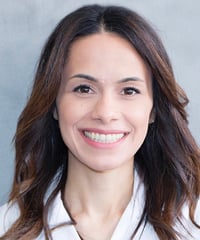
Resident Kiana Rezaei, DMD
Berkeley, CA
Boston University Henry M. Goldman School of Dental Medicine
As a second year AEGD resident at UTHealth School of Dentistry at Houston, Dr. Rezaei has witnessed numerous changes in the program since March 2020. Like many other dental residency curriculums, the UTHealth AEGD program transitioned to online CE courses. CE banking was introduced, where residents took around six hours of CE courses every day and submitted certifications at the end of the week. Residents from the AEGD and GPR programs rotated through a daily on-call schedule to serve patients with dental emergencies. Dr. Rezaei enjoyed the continuing education courses on numerous subjects. These CE courses could have taken a few years to obtain in the pre-COVID era.
The class of 2020 AEGD residents faced the challenge of adapting to the varying pace of the clinic. As the clinic reopened, there was a transition from resident-designated operatories to the rotation of shared operatories. This change helped to achieve proper distancing and containment of aerosol-generating procedures, but it did limit the number of patients each resident could treat compared to pre-pandemic operations. Lab orders also took significantly longer due to staff shortages and shipping delays. Everchanging disinfection protocols and implementation, patient screening (temperature checks, oral rinsing, COVID-19 screening questionnaires, PPE, etc.) has required extra responsibility from staff.
There has also been an undeniable impact on everyone’s experiences. The check-in process for patients is longer due to repeated COVID-19 screening, and patients are not able to bring an escort to the waiting room. This consequence is more profound for elderly patients that are usually accompanied by their family members, and for patients that are receiving treatment under oral sedation. There has been an unprecedented shift from each resident being occupied with their patients and treatments to the limitation of treatment in compliance with COVID-19 safety guidelines. This pandemic has revealed an unbreakable bond amongst the AEGD family at UTSD. From program directors, faculty members, residents, assistants, and office staff, everyone is working more collaboratively and more determined than ever to acquire clinical learning experiences and provide elite dental services to patients.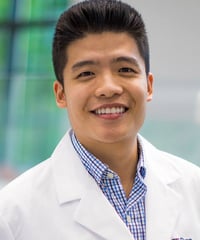
Resident Qingze Lv, DMD
Yancheng, China (F1 Student Visa Holder)
University of Pennsylvania School of Dental Medicine
Dr. Lv was worried about his family in China at the beginning as COVID-19 emerged. Nowadays, things have changed, as he often receives messages from his parents through WeChat about being careful. Dr. Lv was looking forward to his parents coming for his commencement in May 2020 in Philadelphia. Due to the pandemic, the proposed several weeks of school closure in mid-March was prolonged indefinitely, and the commencement was held online instead. One of the challenges that the class of 2020 had to tackle was the licensing exam. The school closed a week before the restorative and scaling and root planning portion of the licensing exam. Through many months of uncertainty, the dental school, and the Commission on Dental Competency Assessments (CDCA) eventually scheduled the mannequin format at the end of June. Dr. Lv, like many of his classmates, had to take days off from residency to return to his dental school for the exam. The traditional live-patient exam imposes several ethical concerns, and organized dentistry such as American Dental Student Association has long proposed a mannequin-based licensing exam. On the positive side, the pandemic catalyzed the early adaptation of non-patient-based licensing exams.
Dr. Lv was surprised that he was able to see patients right away at the beginning of the program. Despite reduced capacity, fewer dental assistants, and less frequent specialist coverage, he appreciates the adaptability of the program, where patients can receive care and residents can learn in a safe environment. Dr. Lv believes that prevention is the key to dentistry. Preventive practices have become especially effective during the pandemic where the patient might not be able to visit the dentist as frequently for routine care. Given the limited aerosol rooms available, Dr. Lv and AEGD residents utilized Silver Diamine Fluoride (SDF) and Prevident 5000 toothpaste to arrest early and intermediate caries. Even when it comes to non-cavitated interproximal caries that have reached the dentin, applying SDF through the spongy super-floss positioned near the contact can help arrest the disease.18 Technology has also been helpful during this time. Many patients choose to have virtual treatment-plan presentations, which saves patients time, parking fees and reduces the risk for exposure.
Dr. Lv is grateful for his residency experience at UTHealth. Under the guidance of the specialist faculty, he has been able to provide procedures such as clinical crown lengthening, guided tissue regeneration, and molar endodontic therapy that he did not experience back in dental school. He also inherited multiple complex cases from a prior resident and has delivered multiple-unit fixed implant prosthesis. He is currently looking forward to finishing up a full-mouth rehabilitation case with the guidance of the AEGD Program Director, who is a board-certified prosthodontist. 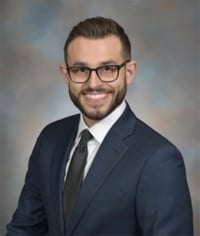
Resident Alexander DeBernardo, DMD
Voorhees, NJ
Case Western Reserve University School of Dental Medicine
Dr. DeBernardo was excited to start his AEGD residency at UTSD. The onset of the COVID-19 pandemic turned a planned week-long spring break vacation into an indefinite closure of his undergraduate clinic. After graduating from Case Western Reserve University in May 2020, Dr. DeBernardo was eager to continue his clinical experiences and perform more advanced procedures at UTHealth. The impact of the pandemic was immediately observed in the limited clinic schedule, assisting rotations, and new infection control protocol/PPE. He initially found the face shields particularly hard to adapt to, as certain face shields would distort light, limit visibility, or alter dimensions of the areas being treated. With repeated use and improved supply of PPE, operating under the new infection control protocols has become second nature.
The implementation of digital dentistry and teledentistry services has greatly helped the patients at UTHealth’s AEGD clinic adapt to receiving care during the pandemic. Dr. DeBernardo has experienced generalized patient anxiety regarding contracting the virus to be a common obstacle. The use of teledentistry to virtually review individual patient treatment plans has been an incredibly useful tool to limit patient visits to the clinic. However, some of his patients that would benefit from virtual treatment planning appointments are older and lack the resources and/or competency of the use of technology required for these appointments. The use of CAD/CAM and digital dentures are tangibly beneficial to most patient populations. Having the ability to limit the number of patient visits while not sacrificing the quality of care has been a rewarding experience.
Dr. DeBernardo feels incredibly fortunate to be working at the UTHealth AEGD clinic. The exemplary leadership and collaboration of both AEGD and GPR directors have facilitated a systematic adaptation to safely provide quality oral health care amidst the COVID-19 pandemic. The efficacy of the enforced safety protocols has allowed the residents to focus on performing treatments and obtaining quality clinical experiences. He is especially grateful for the work environment that has supported continual collaboration to achieve the shared goals of providing quality care and expand clinical knowledge.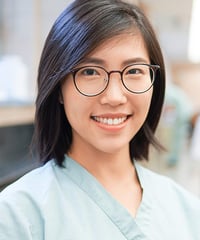
Resident Ellen Liang, DDS
Toronto, Canada (F1 Student Visa Holder)
Faculty of Dentistry, University of Toronto
Dr. Liang had a stressful and difficult time before attending the UTHealth AEGD program. One requirement for entering the AEGD program is that applicants must pass their NDBE Part II examination. However, due to the Canadian government mandated lockdown, testing centers were closed indefinitely. As such, Dr. Liang’s scheduled NDBE exam in March 2020 was canceled. She describes her experience of trying to get her NDBE exam completed as very anxiety-inducing. Due to the number of cancellations, it was almost impossible to get another testing date sooner than several months away, regardless of the province. She spent numerous days refreshing the testing center website to schedule a testing date before the deadline. Even when she was able to schedule another testing date, tests were often canceled a week before, or sometimes even the night before the test. Despite the effort to reschedule, the exam has been canceled a total of seven times. By May 2020, the deadlines were approaching; the results had to be sent to the UTHealth AEGD program by June 2020, and it took 2-3 weeks to obtain the results. In the end, she risked scheduling a test in late May 2020 in Baltimore, Maryland on the starting day of her F1 visa. She was hoping and relying on being permitted to pass the border into the US to make the early June 2020 deadline. Looking back, Dr. Liang notes that she was very lucky. She was able to schedule her test on the day she wanted and was able to pass through the borders to take the test in the US while several of her classmates going to other AEGD programs were rejected. One of the numerous emails Dr. Liang sent found a sympathetic individual, and her passing test results, though unofficial, were forwarded to her AEGD director earlier than usual to meet the UTHealth AEGD entry deadline. The virus not only made it difficult to travel to the AEGD program, but it also made it much more difficult to perform usual activities during the AEGD program. Each year, the residents have a stipend to attend two conferences in different states or countries. However, this year's residents have not been able to travel to any conference. Residents who usually would have returned home for the winter holidays are less inclined to. Dr. Liang chose not to return to Canada for holidays, as she would have to quarantine at home for her entire stay. She would also risk not being able to cross the border back to the US.
Overall, resident Ellen Liang feels very thankful to be in the program, despite the difficulties getting there and not being able to travel. She reports that several of her undergraduate classmates attending AEGD programs lost months of clinic time due to lockdown, or they were only able to treat emergency patients, or 1-2 patients a day. However, the UTHealth AEGD has allowed its residents to work on numerous patients a day since day one of the program, thus giving residents precious clinic time that they lost in their last year of undergraduate study.
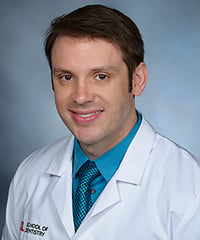
Resident Marcelo Durski, DDS, MSD, PhD
Louisville, KY
University of Louisville School of Dentistry
Marcelo Durski believes that the COVID pandemic has changed how dentistry has been done for years. At the start of the pandemic, all dentists, dental hygienists, faculty members, students, residents, dental assistants, and staff were very fearful of what the future would hold. Now, Dr. Durski feels that the dental community has accepted the existence of COVID-19 and adapted to new work habits:
“We’ve never experienced a pandemic. When the pandemic started in March 2020, it was challenging to formulate ways to deal with it. Decisions had to be made immediately. Over time, some decisions had to be taken back or changed due to new considerations. So, everyone was lost, including me, since there was a learning curve for each new change made.”
In Dr. Durski’s opinion, COVID-19 has introduced both negative and positive impacts on his 2020-2021 AEGD residency training. Lectures now take place online, allowing residents to easily watch presentations from their office desks or their homes. On the other hand, online lectures have compromised student-teacher interactions and relationships. He thinks that physically gathering with other residents creates a better learning environment, as it allows more interactive lectures because students are more focused. With two young children at home, other tasks can be easily introduced, which can distract him from learning.
“The coronavirus pandemic has brought a lot of new challenges. Healthcare providers have changed their working and personal habits considerably in positive ways. We are more conscious of all kinds of possible diseases and have become more considerate about others' health.”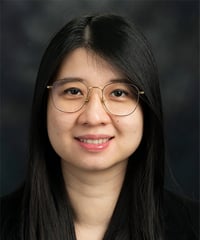
Pensiri Saenthaveesuk, DDS, MSD
Khon Kaen, Thailand (F1 Student Visa Holder, Thai Dental Geriatrics Scholarship)
Faculty of Dentistry, Khon Kaen University
Dr. Saenthaveesuk has been able to adapt well to the COVID-19 pandemic. It was an unprecedented time for her to return to general dentistry after working as a faculty member of Oral and Maxillofacial Surgery for seven years. She has been in the US since December 2019 and started a fellowship program in January 2020. During the lockdown period from the end of March to May 2020, Dr. Saenthaveesuk has completed a plethora of online continuing dental education courses to accomplish the assignment of obtaining at least six CE credits per day. This time allowed her to prepare and review valuable knowledge of general dentistry before starting the AEGD program at UTHealth. The benefits of attending the CEs and webinars during the pandemic helped her to achieve the requirement of the minimum 500 CE credits for the Fellowship of Academy of General Dentistry (FAGD) award within six months. Moreover, she had the opportunity to enroll in the newly established Dental Informatics program at UTSD concurrently with the AEGD residency and her PhD programs. Looking at the practice of dentistry during the pandemic, all training under the national and school policies allowed clinicians to quickly adopt safe practices and return to treating patients appropriately with routine practice. Therefore, Dr. Saenthaveesuk is grateful for the leadership of the UTSD for providing a well-organized clinical practice policy and training course to all staff, residents, and students during the COVID-19 era.
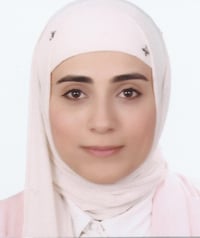
Resident Alaa Alsaffar, BDM
Kuwait City, Kuwait (F1 Student Visa Holder, Kuwait Ministry of Health Scholarship)
Kuwait University, Faculty of Dentistry
Dr. AlSaffar was also enrolled in an AEGD fellowship when the COVID-19 pandemic reached the US. When the pandemic started, the whole world went from 100% operation to lockdown quickly. She believes the pandemic brought challenges as well as blessings. Some of the challenges included the transition between her fellowship and AEGD residency program.
In May 2020, the embassy of Kuwait sent out invitations to its citizens to evacuate the foreign country they were in and return home. Although Dr. Alsaffar was very thankful for the opportunity to return home, she was uncertain if she would be able to return to the program on time and was afraid of losing her opportunity at the UTHealth AEGD program. Although she decided to stay in the US, she still faced some difficulty in finishing scholarship paperwork back home in Kuwait. To surpass this obstacle, Dr. Alsaffar’s family back home worked hard to physically get paperwork completed on her behalf through the understanding of the Kuwaiti government and amidst the special circumstances. Dr. Alsaffar had many sleepless nights over 3-4 weeks while she was trying to contact family back home to monitor any progress. However, some of her friends in other dental residencies evacuated and were able to return to the US to resume their residencies after the borders reopened. This was an important factor in Dr. AlSaffar’s decision to return home during the 2020 winter holidays to complete any remaining paperwork. That trip proved to be a success despite its challenges. Before leaving the US, Dr. AlSaffar and her family had to have a negative COVID-19 PCR test result. Once they arrived in Kuwait, she had to quarantine before she was able to complete her paperwork. Her return to the US was uneventful and smooth. Before returning to work, Dr. AlSaffar obtained a negative test result to ensure the protection of her and her coworkers.
Despite all the challenges, Dr. AlSaffar found that the pandemic had a bright side, it made people look for other ways to perform tasks, including online continuing education courses, teledentistry, CAD/CAM, and digital dentures. The slow transition to maximum occupancy allowed incoming residents to adapt to a new workplace, which was especially valuable if they were traveling from a foreign country. Free online education courses, in addition to providing fruitful information, provided easier pathways for dentists to work towards their Fellowship of Academy of General Dentistry (FAGD) award or Mastership of Academy of General Dentistry (MAGD), as these CE credits also counted towards the American Board of General Dentistry requirements.
“Everything in life has a bright and dark side, it's just which side you want to concentrate on!”
Looking Forward and Moving Forward
The dental professionals have been proactive in following the CDC and ADA guidelines during COVID-19 pandemic. Despite the higher risk for exposure through common aerosol-generating procedures, the positive rate for dentists was reported to be less than 1%.19 PPE such as gloves, eye shields, surgical masks, and gowns have been common practices in the field of dentistry. The upgraded PPE such as N95 masks and face shields will likely remain the standard of care for the foreseeable future. In addition to intraoral suction, extraoral suction products have been developed during the pandemic. Sanitizing products, such as UV lamps, have also made their way into many dental practices. The technology to reduce aerosols and enhance sanitization will surely keep evolving. Artificial intelligence, robotic, and technology innovations are transforming practice in dentistry.
By the end of 2020, the FDA has granted emergency use authorization for the Pfizer and Moderna vaccines.20 UTHealth has been procuring vaccines for employees, students, residents, faculty, and staff. All residents received the second dose of the Moderna vaccine by the end of January 2021. Nevertheless, a new strain of COVID-19 (VUI-202012/01) has been reported from the UK. Despite the unpredictability of the new strain, the vaccine is still expected to be effective.21 The pandemic may last, but the adaptability of the dental professionals will help them continue to provide essential care for patients and communities.
By the end of 2020, Harris County of Texas, where the UTHealth Houston AEGD residency program is located, remained one of the top US and global major epicenters of the pandemic. With constant surveillance of each infection control protocol phase, the UTHealth Houston AEGD clinic has sequentially expanded to operate at 100% capacity with zero incidence of COVID-19 exposure of residents, faculty, and clinic staff, to date. Leadership, adaptation, teamwork, and positive encouragement have made the AEGD experiences truly unique and a beacon of hope during this time of uncertainty. This pandemic has revealed an unbreakable bond amongst the UTHealth Houston AEGD family, everyone is working more collaboratively and more determined than ever to acquire safe clinical learning experiences and provide elite and safe dental services to patients.
__________
Qingze Lv, Alexander DeBernardo, Ellen Liang, Alaa Alsaffar, Marcelo Durski, Kiana Rezaei, Pensiri Saenthaveesuk, Sudarat Kiat-amnuay
References
- United States Department of Labor. Occupational Safety and Health Administration. https://www.osha.gov/SLTC/covid-19/background.html.
- Rosa, G. L., Mancini, P., Ferraro, G. B., Veneri, C., Iaconelli, M., Bonadonna, L., Suffredini, E. (2020). SARS-CoV-2 has been circulating in northern Italy since December 2019: Evidence from environmental monitoring. doi:10.1101/2020.06.25.20140061
- ADA American Dental Association. Accessed December 10,2020. ADA offers interim guidance as some states consider reopening. https://www.ada.org/en/publications/ada-news/2020-archive/april/ada-offers-interim-guidance-as-dentists-consider-reopening-practices.
- CDC Center for Disease Control and Prevention. Accessed December 10,2020. Guidance for Dental Settings. https://www.cdc.gov/coronavirus/2019-ncov/hcp/dental-settings.html.
- ADA Center for Professional Success. COVID-19 State Mandates and Recommendations. Accessed December 10,2020. https://success.ada.org/en/practice-management/patients/covid-19-state-mandates-and-recommendations.
- COVID-19 In Texas (Dashboard). Accessed December 23, 2020. https://txdshs.maps.arcgis.com/apps/opsdashboard/index.html
- American Dental Education Association (ADEA). Rising to the Challenge: Dental Schools Join the Fight Against COVID-19. https://www.adea.org/Articles/Oct2020-Dental-Schools-Fight-Against-COVID19/
- Vindegaard, N., & Benros, M. E. (2020). COVID-19 pandemic and mental health consequences: Systematic review of the current evidence. Brain, Behavior, and Immunity, 89, 531-542. doi:10.1016/j.bbi.2020.05.048
- CARES Act offers federal student loan relief to dentists. Accessed Jan 10, 2021. https://www.ada.org/en/publications/new-dentist-news/2020-archive/april/cares-act-offers-federal-student-loan-relief-to-dentists#:~:text=Dentists%20with%20federal%20student%20loans,by%20the%20COVID%2D19%20pandemic.&text=Dentists%20with%20outstanding%20federal%20student,from%20March%2013%20through%20Sept.
- COVID-19 Frequently Asked Questions. Accessed Jan 15, 2020. https://success.ada.org/en/practice-management/patients/coronavirus-frequently-asked-questions
- How technology can help patients understand their health status and buy in to the solution. Accessed Jan 9, 2020. https://www.dentaleconomics.com/science-tech/article/14189612/case-acceptance-how-dental-technology-can-help-patients-understand-their-oral-health-status-and-buy-in-to-the-solution
- Ghai S. (2020). Teledentistry during COVID-19 pandemic. Diabetes & metabolic syndrome, 14(5), 933–935. https://doi.org/10.1016/j.dsx.2020.06.029
- Rahman, N., Nathwani, S. & Kandiah, T. Teledentistry from a patient perspective during the coronavirus pandemic. Br Dent J (2020). https://doi.org/10.1038/s41415-020-1919-610. https://www.ada.org/en/publications/ada-news/2020-archive/june/ada-responds-to-change-from-cdc-on-waiting-period-length
- People with Certain Medical Conditions. Accessed Jan 9, 2021. https://www.cdc.gov/coronavirus/2019-ncov/need-extra-precautions/people-with-medical-conditions.html
- COVID-19 Hospitalization and Death by Age. Accessed Jan 9, 2021. https://www.cdc.gov/coronavirus/2019-ncov/covid-data/investigations-discovery/hospitalization-death-by-age.html,
- Aging in Texas: Introduction. Accessed Jan 20, 2021. https://demographics.texas.gov/resources/publications/2016/2016_06_07_aging.pdf
- ECHO. Accessed Jan 25, 2021. https://hsc.unm.edu/echo/
- Seifo, N., Cassie, H., Radford, J. R., & Innes, N. P. (2019). Silver diamine fluoride for managing carious lesions: An umbrella review. BMC Oral Health, 19(1). doi:10.1186/s12903-019-0830-5
- Report Finds COVID-19 Rate Among Dentists is Less than One Percent. https://www.ada.org/en/press-room/news-releases/2020-archives/october/report-finds-covid-19-rate-among-dentists-is-less-than-one-percent
- Covid-19 Vaccines. https://www.fda.gov/emergency-preparedness-and-response/coronavirus-disease-2019-covid-19/covid-19-vaccines#eua-vaccines
- Covid-19: New coronavirus variant is identified in UK. https://www.bmj.com/content/371/bmj.m4857/rapid-responses

